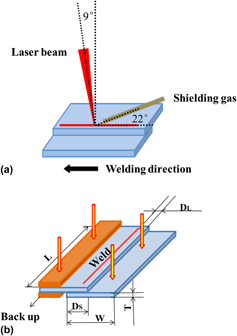Crossref Citations
This article has been cited by the following publications. This list is generated based on data provided by
Crossref.
Zhang, Yulong
Lu, Fenggui
Cui, Haichao
Cai, Yan
Guo, Songtao
and
Tang, Xinhua
2016.
Investigation on the effects of parameters on hot cracking and tensile shear strength of overlap joint in laser welding dissimilar Al alloys.
The International Journal of Advanced Manufacturing Technology,
Vol. 86,
Issue. 9-12,
p.
2895.
Wei, Haoyan
He, Qizhi
Chen, Jiun-Shyan
Wang, Hui-Ping
and
Carlson, Blair E.
2017.
Coupled thermal-mechanical-contact analysis of hot cracking in laser welded lap joints.
Journal of Laser Applications,
Vol. 29,
Issue. 2,
Mao, Ling
Jin, Huijin
Ye, Fan
Wang, Feifei
Zheng, Gang
and
Wu, Sujun
2018.
Effect of thermal cycles on the laser beam welded joint of AA2060 alloys.
Journal of Materials Research,
Vol. 33,
Issue. 20,
p.
3439.
He, Qizhi
Wei, Haoyan
Chen, Jiun-Shyan
Wang, Hui-Ping
and
Carlson, Blair E.
2018.
Analysis of hot cracking during lap joint laser welding processes using the melting state-based thermomechanical modeling approach.
The International Journal of Advanced Manufacturing Technology,
Vol. 94,
Issue. 9-12,
p.
4373.
Mercan, Emine
Ayan, Yusuf
and
Kahraman, Nizamettin
2020.
Investigation on joint properties of AA5754 and AA6013 dissimilar aluminum alloys welded using automatic GMAW.
Engineering Science and Technology, an International Journal,
Vol. 23,
Issue. 4,
p.
723.
Wang, Qian
Shen, Junqi
Hu, Shengsun
Zhao, Guancheng
and
Zhou, Jie
2020.
Microstructure and Mechanical Properties of Fe-36Ni and 304L Dissimilar Alloy Lap Joints by Pulsed Gas Tungsten Arc Welding.
Materials,
Vol. 13,
Issue. 18,
p.
4016.
Albannai, Abdulaziz
Aloraier, Abdulkareem
Alaskari, Ayman
Alawadhi, Meshal
and
Joshi, Suraj
2021.
Effects of tandem side-by-side GTAW welds on centerline solidification cracking of AA2024.
Manufacturing Technology,
Vol. 21,
Issue. 2,
p.
151.
Kimthong, P.
Wattanapornphan, P.
Phongphisutthinan, C.
and
Uthaisangsuk, V.
2021.
Experimental investigations and FE modeling considering microstructural inhomogeneity of laser welded steel-aluminum joints.
Archives of Civil and Mechanical Engineering,
Vol. 22,
Issue. 1,
Zhao, Shifang
2022.
Effect of laser offset on microstructure and mechanical properties of Ir–Rh/Ni-based alloy.
The International Journal of Advanced Manufacturing Technology,
Vol. 119,
Issue. 7-8,
p.
4893.
Cen, Yaodong
Chen, Lin
and
Ma, Xiao
2023.
Characteristics and Weldability of Resistance Plug Welding of Dissimilar Steels.
Journal of Wuhan University of Technology-Mater. Sci. Ed.,
Vol. 38,
Issue. 6,
p.
1463.
Harachai, Komsak
and
Prasomthong, Suriya
2023.
Investigation of the optimal parameters for butt joints in a friction stir welding (FSW) process with dissimilar aluminium alloys.
Materials Research Express,
Vol. 10,
Issue. 2,
p.
026514.
Norouzian, Mohammadhossein
Amne Elahi, Mahdi
and
Plapper, Peter
2023.
A review: Suppression of the solidification cracks in the laser welding process by controlling the grain structure and chemical compositions.
Journal of Advanced Joining Processes,
Vol. 7,
Issue. ,
p.
100139.
Wang, Yaochao
Li, Mengnie
Yang, Xiaoyi
and
Zuo, Hanning
2023.
Effect of P-MIG and CMT on microstructure and properties of 6082-T6 joints.
Materials Science and Technology,
Vol. 39,
Issue. 15,
p.
2074.
Soysal, Tayfun
2025.
Solidification crack susceptibility of 5xxx aluminum alloys.
Welding in the World,
Bobach, Billy-Joe
Boman, Romain
Carbonell, Josep Maria
Papeleux, Luc
Fernandez, Eduardo
and
Ponthot, Jean-Philippe
2025.
A Unified Thermo-Fluid–Solid Formulation for FSI and Phase Change Problems Based on the Particle Finite Element Method.
International Journal of Computational Methods,
Vol. 22,
Issue. 03,
